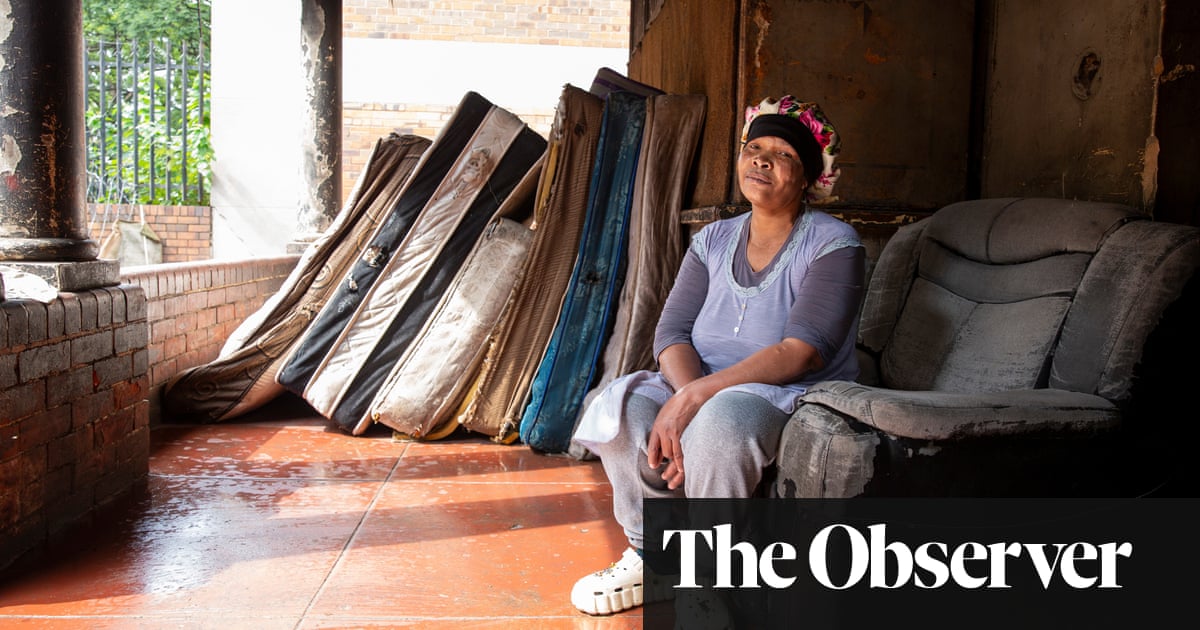Bethabile Mavis Manqele mops the veranda of the house she has lived in for most of the last 40 years. The ceiling above her is full of holes, blackened by years of cooking fires. Manqele, 64, isn’t sure how many people live in the house’s seven rooms. There are no utilities, the landlord is absent and she hasn’t paid rent in years, she says through a translator. The occupants share a portable toilet provided and cleaned by an NGO, plus one outdoor tap with the house next door, which has no roof.
Manqele’s home in the inner city district of Berea is emblematic of Johannesburg’s downtown, which was progressively abandoned by wealthy people, businesses and government from the 1980s.Hundreds of buildingsleft empty by landlords are now overcrowded, and the area is notorious for crime.
Beyond the inner city, the shine is coming off the City of Gold, with growing numbers of residents dissatisfied with basic services such as water and roads, according to the latest quality of life survey by the Gauteng City-Region Observatory. In March South Africa’s presidentCyril Ramaphosacriticised the environment as being “not pleasing” and set up a presidential working group to“revive” Johannesburgbefore it hosts the G20 summit in November.
Meanwhile, artists and businesspeople are rallying to defend their city. “It’s always hustling – there’s an energy,” says Stephen du Preez, who manages 11 business improvement districts and volunteers with Jozi My Jozi, a business coalition launched in 2023 to spruce up downtown. “They’re friendly; they’re damn good people.”
There are now about 140 businesses donating to Jozi My Jozi, with 75m rand (£3m) spent in two years on projects such as installing 613 solar-powered streetlights. The initiative, which Du Preez says works with local communities rather than gentrifying them, is also expanding to the former black-only township of Soweto.
Previous efforts to regenerate inner-city districts, such as the trendy area of Maboneng, have excluded those living there, says Edward Molopi of the Socio-Economic Rights Institute ofSouth Africa(Seri), an NGO supporting Manqele and her neighbours. He says these efforts often involve evicting residents then raising rents: “Is there a place for the poor in the inner city? Many of these initiatives will answer in the negative.
Johannesburg is a highly unequal city in theworld’s most unequal country. The new business district, Sandton, is known as “Africa’s richest square mile”. An estimated 1million trees were planted when the city was built on Highveld grassland in 1886, forming one of the world’slargest urban forests. But the townships, created by the apartheid regime in the mid-20th century to force non-white people to the city’s margins, are far less lush.
At the city’s birth, when gold was discovered, black male migrant workers lived in mine camps in the south, white “Randlords” in northern hilltop mansions, and more mixed communities between. “There were these social fractures in the city at the very beginning,” says Noor Nieftagodien, a history professor at the University of the Witwatersrand.
While Johannesburg’s problems have always hit the poorest the hardest, middle-class complaints are growing louder as issues such as water outages spread to the suburbs. Political instability – the city has had eight mayors in the past four years – and corruption are often blamed.
The inner city’s issues culminated in tragedy in 2023, when77 people were killedin a fire at80 Albert Road, an overcrowded apartment building owned by the city. An inquiry blamed neglect by local authorities and the provincial premier pledged to act on its recommendations.
The city government is implementing a “bad buildings strategy” to deal with “hijacked” buildings, spokesperson Virgil James says, noting there are court orders “to evacuate the occupiers to a temporary emergency accommodation” from six buildings.
In Manhattan Court, a 108-room apartment building on a bustling shopping street, residents are collectively paying 25,000 rand a month to the city for services and to try to secure ownership of their homes, says Noma Qwele, a residents’ committee member who has lived there since 1986.
They also pay for maintenance and security, but they still don’t know who the building’s owner is after it was sold in an auction, Qwele says, adding: “The building is for us. It’s our home.”
Sifiso Zuma of the Inner City Foundation, an NGO supporting Manhattan Court, says: “If you are poor, they don’t care about you. Because tThose people who are living in occupied buildings, they are willing to pay for basic services, but the city – it doesn’t want to talk to them.”
In Fordsburg, another inner city district, the outer wall of the Bag Factory glows with an orange mural by artist Levy Pooe. The studios, founded in 1991, are home to nine long-term artists and six younger ones on bursaries.
“It’s always been a very vibrant city,” says Ndaya Ilunga, who was born in Johannesburg in 1995 after her parents fled the Democratic Republic of Congo, gesturing amid her vividAfrofuturistworks. “I feel like I’m now part of that, those people who create that energy.”
